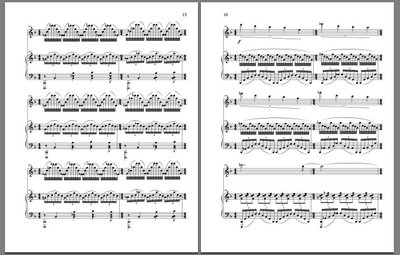 I met Elena and Alexei when they performed in the 2001 Austrian production of A Little Girl Dreams of Taking the Veil, Alexei on the podium and Elena covering the viola, my favorite bit of which is the brief and registrally displaced but oh so beautiful solo here:
I met Elena and Alexei when they performed in the 2001 Austrian production of A Little Girl Dreams of Taking the Veil, Alexei on the podium and Elena covering the viola, my favorite bit of which is the brief and registrally displaced but oh so beautiful solo here:
I had promised them a piece in their roles as the members of a violin-piano duo, and this for many years, giving them only one small number that was a simply bit of program music, an old man dies, a vision of my own death as an old man, gasping for breath but all the while still dreaming of a breast, the iconic breast of a woman. However, I finally forced myself to sit down and write something, not asking them if they still cared or wanted the heavy responsibility of another piece dedicated to them, this one not quite so simple. This spicy opus, The Secret of Success, a reference to a blog entry here by the same name, is subtitled a chaconne, because it is, at least a bit, and in the modern meaning as a set of variations on a repeating harmonic progression, in this case a series of chords rooted on Bb, a combinatorial set that treads between major and minor, similar to those I have used before: once in The Bed You Sleep In and once in the Cotter episode in Queer. The piano plays incessantly, often verbosely, and typically the harmonic changes happen right on the measure line, one per measure, violin and piano almost always changing together, something that Kyle Gann would probably find crazy making. From a recent post of his that was on my mind while I was scribbling:
When I see a kid composing in units of measure, measure, measure, with a new impetus, new phrase, new harmony on every downbeat, I start in with my wheedling tone (every experienced composition student will recognize the sound): "How about a triple upbeat to start that melody off a little more gracefully?" "How about we vary the harmonic rhythm here?" "You think the audience can't hear where your bar-lines are if you don't accent every one?"






5 comments:
The violn part certainly isn't easy. It's playable, though, with the notes ranging across all four strings in the vicinity of 3rd and 5th positions.
Well heavens, Erling, you do all the same kinds of things I do in that situation to create rhythmic variety and obscure the bar line: the alternation of meters, the off-beat accompaniment, the quintuplets and quadruplets across the measure. Were you my student I'd pat you on the back and say, "Superb! What next?"
Michael: good to hear it's playable. I did place my fingers on a properly scaled diagram of the fingerboard just to see if I was way off, but not being a violinist one is never quite sure. I assumed Elena would give me a talking to if I messed up and then I could adjust.
Kyle: whew! Obviously I shouldn't live in quite so much fear of you, but even under the eyes of my own personal watchful composition judge, I worry whether I'm being too blocky, i.e., harmony 1 to harmony 2 to harmony 3 to etc, and I worry that I'm using a 4 chord sequence - 4 being such a typical phrase - and I worry that, even though I am using quintuplets and more, most of the actual note patterns are starting and stopping in lockstep with the beat. My composition judge, who seems to be stuck in a high modern post-war mindset, says: "be more complicated, complexity engenders respect, obfuscate everything more and more and more." When I was a student I made a point of having no events anywhere line up with anything. I obliterated regularity in the Elliot Carter way, as you reference, with Xs in the times of Y of all sorts careening across the barlines bracketing all sorts of dots and flags scattered about inside. I'm sensitive to the idea that I've moved too far in the other direction.
Boy, Erling, we should really talk sometime, we're so on the same wavelength. I think you and I are among the people (or generation) who so internalized irregularity that we need never fear that we're getting too simple - the furthest we can go in that direction, we could always go a little further and still be pretty way out.
Post a Comment